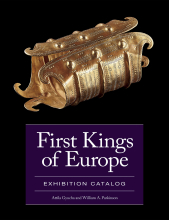Stag appliqué - Catalog No. 100
Record details
Fettich 1928; Kemenczei 1999c
Gyucha, Attila and William A. Parkinson, 2023. Stag appliqué - Catalog No. 100 for First Kings of Europe: Exhibition Catalog. Version 1. Cotsen Institute of Archaeology Press. https://doi.org/10.25346/S6/OOTNPS
This golden appliqué came from the burial mound of a member of the Iron Age elite of the eastern Carpathian Basin. In terms of style and design, the best analogies for the object are from the tombs of Scythian rulers recovered beneath large burial mounds in the Pontic steppe and the Kuban region. These analogies, possibly produced in Greek colonies, such as Olbia on the Black Sea coast in eastern Ukraine, suggest that this appliqué, perhaps of a similar origin, was attached to a quiver, or less likely a shield, and served as a status symbol. The close resemblance between the gold stags from the Pontic steppe and the Carpathian Basin signifies the strong ties maintained by the elites of these remote regions.
Bence Soós
